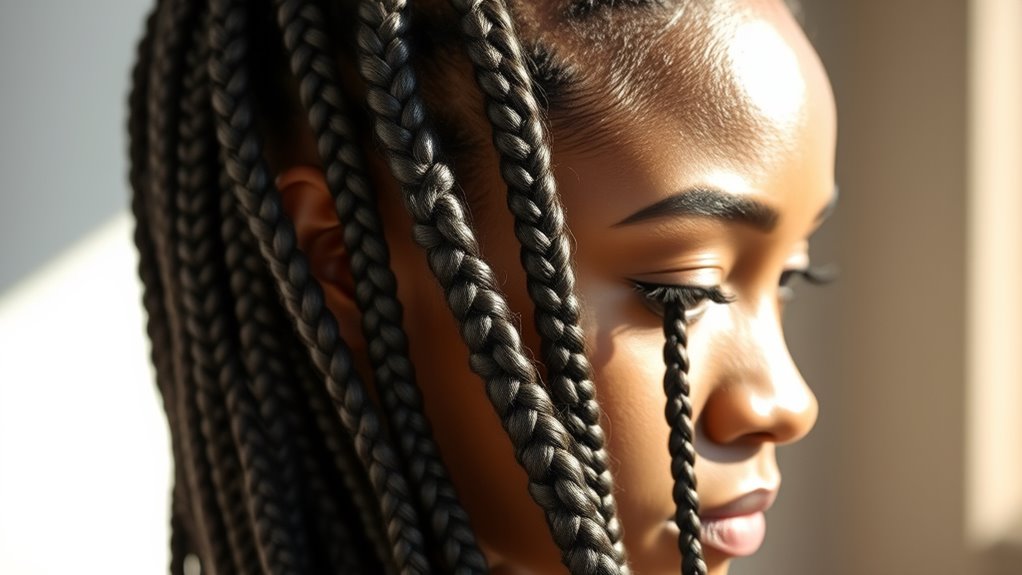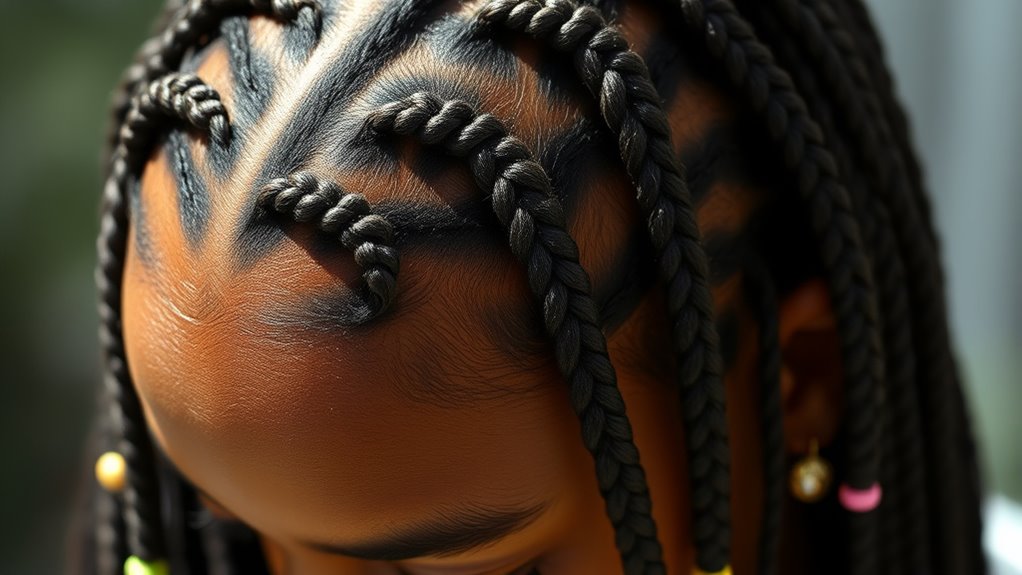Protective styles generally last between four to eight weeks, but the exact time depends on your hair type, style, and how well you care for it. If you have fine or fragile hair, aim for four to six weeks to avoid damage. Thicker, resilient hair can often stay protected for up to eight weeks. To guarantee your hair stays healthy, it’s best to monitor it closely—keep going, and you’ll discover effective tips to maximize your style’s lifespan.
Key Takeaways
- Protective styles typically last between 4 to 8 weeks, depending on individual hair type and style choice.
- Fine or fragile hair should be maintained for 4-6 weeks to prevent damage.
- Thicker, resilient hair can usually stay in styles up to 8 weeks with proper care.
- Regular scalp monitoring and moisturizing are essential during wear to prevent dryness and breakage.
- Signs like excessive shedding, itching, or discomfort indicate it’s time to remove or redo the style.

Have you ever wondered how long you can keep protective styles in without risking damage? The answer depends on several factors, including your hair type, the style you choose, and how well you follow your hair care routines. Protective styles like braids, twists, or wigs are designed to shield your natural hair from daily wear and tear, but wearing them for too long can lead to issues like breakage, thinning, or scalp problems. That’s why understanding the right timelines for styling maintenance is essential to keeping your hair healthy and looking its best.
Typically, protective styles can stay in for about 4 to 8 weeks. However, this isn’t a one-size-fits-all rule. For instance, if you have fine or fragile hair, staying within the 4 to 6-week range is generally safer. On the other hand, those with thicker, more resilient hair might be able to extend this period up to 8 weeks, but it’s essential to monitor your scalp and hair health throughout. During this time, maintaining a consistent hair care routine is critical. Regularly moisturizing your scalp, using gentle cleansers, and applying lightweight oils can help prevent dryness and scalp irritation.
Protective styles last 4 to 8 weeks, but adjust based on your hair’s needs and scalp health.
When it comes to styling maintenance, it’s essential to keep your scalp clean and free of product buildup. This means carefully washing your hair and scalp without disturbing the style or causing unnecessary tension. Using a diluted shampoo or a scalp refresher spray can make this process easier and more effective. Additionally, covering your hair at night with a silk or satin bonnet helps reduce friction and moisture loss, prolonging the integrity of your protective style. Proper protective styling practices can significantly extend the lifespan of your styles and protect your hair’s health.
It’s equally important to pay attention to your hair’s signals. If you notice excessive shedding, scalp itching, or breakage, it’s a sign that your protective style has been in too long and needs to come out. Removing styles promptly allows your hair to breathe, recover, and be properly cared for. When taking down your protective style, gently detangle and follow a thorough hair care routine, including deep conditioning, to restore moisture and strength.
Frequently Asked Questions
Can Protective Styles Cause Permanent Damage to Natural Hair?
Protective styles can cause damage if you’re not careful, but they don’t typically lead to permanent harm. The damage risk mainly involves hair breakage and scalp tension from tight styles. To avoid this, don’t keep styles in too long, and listen to your hair’s needs. Proper care, gentle removal, and regular moisturizing help prevent damage, ensuring your natural hair stays healthy and strong without permanent issues.
How Do Weather Conditions Affect the Longevity of Protective Styles?
Weather impact and seasonal changes can considerably affect how long your protective styles last. Humidity, rain, and extreme heat can cause your styles to loosen or frizz faster, while cold, dry weather might lead to dryness and breakage. You should adjust your hair care routine accordingly, keeping your scalp moisturized and protecting your styles from the elements. This helps maintain your protective style longer despite changing weather conditions.
Are There Specific Products Recommended to Extend Protective Style Lifespan?
Think of your protective style as a delicate garden needing the right tools. To extend its lifespan, you should focus on product selection, choosing lightweight oils and moisturizing sprays that nourish without weighing down. Incorporate styling techniques like gentle re-twisting or wrapping at night. These strategies act as the gardener’s hands, ensuring your style stays vibrant and healthy, so you enjoy your look longer and minimize damage.
How Often Should I Schedule Professional Touch-Ups for My Style?
You should schedule professional touch-ups every 4 to 6 weeks to support healthy hair growth and keep your style looking fresh. Regular maintenance tips include moisturizing your scalp, avoiding excessive tension, and gently detangling. By sticking to this schedule, you help prevent damage and ensure your protective style stays neat and lasts longer. Consistent visits also allow your stylist to address any issues early, promoting overall hair health.
What Are Signs That My Protective Style Needs to Be Removed?
Ever wonder if it’s time to take down your protective style? Signs include scalp irritation, which signals discomfort or buildup, and style loosening, showing it’s no longer secure. If your hair feels excessively tangled or you notice increased breakage, these are also clues. Don’t ignore these signals—removing your style at the right time helps maintain healthy hair and scalp, preventing damage and ensuring your hair stays strong and vibrant.
Conclusion
Remember, protective styles are like a fine-tuned garden—you need to give them the right care and time. I once kept a protective style for six weeks, and just like a garden that flourishes with patience, my hair stayed healthy and vibrant. On average, styles should stay in for about 4 to 8 weeks to prevent damage. Treat your hair like a precious treasure, and it’ll reward you with strength and shine.








